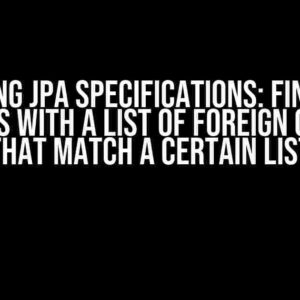Are you tired of dealing with the pesky `.focus()` function not working as expected when navigating between .xaml files in your MAUI (Mobile Android) application? You’re not alone! In this article, we’ll delve into the mystery behind this issue and provide you with clear, step-by-step solutions to get your focus back on track.
The Problem
When developing a MAUI application, you might have encountered a scenario where you need to navigate between multiple .xaml files. Sounds straightforward, right? However, things take a turn for the worse when you try to use the JavaScript `.focus()` function to set focus on a specific element in your UI. Suddenly, your carefully crafted code stops working, leaving you scratching your head.
<Entry x:Name="myEntry" />
<Button Clicked="MyButton_Clicked">Click me!</Button>In the above example, let’s say you want to set focus on the `myEntry` Entry control when the button is clicked. You would typically use the `.focus()` function like this:
myEntry.Focus();But, alas! When you navigate to another .xaml file and come back to this page, the `.focus()` function ceases to work. What’s going on?
The Reason
The culprit behind this issue lies in the way MAUI handles page navigation. When you navigate to a new .xaml file, the previous page is unloaded from memory, and all its JavaScript resources are released. This means that any JavaScript code related to the previous page, including event handlers, is lost.
When you return to the original page, MAUI recreates the page from scratch, but it doesn’t restore the JavaScript context. As a result, any attempts to call the `.focus()` function fail, since the underlying JavaScript engine is no longer aware of the previous page’s elements.
The Solution
Fear not, dear developer! There are a few ways to overcome this limitation and get your `.focus()` function working again:
Method 1: Use a ViewModel
One approach is to use a ViewModel to manage your page’s state. By storing the focus state in the ViewModel, you can restore it when the page is recreated.
public class MyViewModel : INotifyPropertyChanged
{
private bool _hasFocus;
public bool HasFocus
{
get { return _hasFocus; }
set
{
_hasFocus = value;
OnPropertyChanged(nameof(HasFocus));
}
}
public void SetFocus()
{
HasFocus = true;
}
}In your .xaml file, bind the `HasFocus` property to the `IsFocused` property of your Entry control:
<Entry x:Name="myEntry" IsFocused="{Binding HasFocus}" />Now, when you navigate away and come back to the page, the ViewModel will restore the focus state, and the `.focus()` function will work as expected.
Method 2: Use a Custom Renderer
Another approach is to create a custom renderer for your Entry control. This allows you to execute native code to set focus on the control when the page is recreated.
public class MyEntryRenderer : EntryRenderer
{
public override void LayoutSubviews()
{
base.LayoutSubviews();
Control.BecomeFirstResponder();
}
}In your .xaml file, use the custom renderer:
<local:MyEntry x:Name="myEntry" />This method provides a more native solution, but it requires more effort to implement and maintain.
Method 3: Use JavaScript to Re-add Event Handlers
A third approach is to re-add the event handlers in JavaScript when the page is recreated. This can be achieved by creating a separate JavaScript file and loading it in your .xaml file using the `WebView` control.
<WebView x:Name="myWebView" Source="myjavascriptfile.js" />In your JavaScript file, re-add the event handlers:
function setPageFocus() {
document.addEventListener("DOMContentLoaded", function () {
document.getElementById("myEntry").focus();
});
}Call the `setPageFocus()` function in your .xaml.cs file when the page is loaded:
public MyPage()
{
InitializeComponent();
myWebView.EvaluateJavaScript("setPageFocus()");
}This method is more straightforward, but it relies on JavaScript and might not be as efficient as the other methods.
Conclusion
Moving between .xaml files in MAUI can indeed cause issues with the JavaScript `.focus()` function. However, by using one of the methods outlined above, you can overcome this limitation and get your focus back on track.
Remember, whether you choose to use a ViewModel, custom renderer, or JavaScript-based solution, the key is to understand how MAUI handles page navigation and adapt your code accordingly. With a little creativity and perseverance, you’ll be able to focus on what really matters – building an amazing MAUI application!
Table of Contents
- Moving between .xaml files ruins JavaScript `.focus()` function in MAUI (Mobile Android)
- The Problem
- The Reason
- The Solution
- Method 1: Use a ViewModel
- Method 2: Use a Custom Renderer
- Method 3: Use JavaScript to Re-add Event Handlers
- Conclusion
- Table of Contents
Hope this article has helped you solve the pesky `.focus()` issue in MAUI! If you have any further questions or need more assistance, don’t hesitate to ask.
Frequently Asked Question
Moving between .xaml files can be a real pain in MAUI, especially when it comes to JavaScript focus functions. Don’t worry, we’ve got you covered! Here are some frequently asked questions and answers to help you navigate this issue:
Why does moving between .xaml files ruin my JavaScript focus function?
When you navigate between .xaml files in MAUI, the JavaScript context is reinitialized, which means any previously set focus states are lost. This is because the JavaScript engine is restarted, and all previous references to elements are invalidated. To avoid this, you can try to reattach the focus event listeners or use a different approach to manage focus states.
How can I preserve the focus state when navigating between .xaml files?
One way to preserve the focus state is to use a global JavaScript variable to store the currently focused element’s ID. When navigating to a new .xaml file, you can then retrieve this ID and reapply the focus using JavaScript. Alternatively, you can use a more robust state management system, such as a JavaScript singleton or a MVVM framework, to persist the focus state across page navigations.
Can I use a timer to reapply the focus after navigation?
Yes, you can use a timer to reapply the focus after navigation. However, be cautious when using this approach, as it may lead to timing issues or unexpected behavior. A better approach would be to use the page’s OnAppearing or OnNavigatedTo events to reattach the focus event listeners or reapply the focus state.
Is there a way to avoid JavaScript reinitialization when navigating between .xaml files?
Unfortunately, there is no built-in way to avoid JavaScript reinitialization when navigating between .xaml files in MAUI. However, you can try to minimize the impact by using a single JavaScript file that is shared across all .xaml files, or by using a framework that provides better support for JavaScript persistence, such as a single-page application framework.
Are there any workarounds for this issue in MAUI?
Yes, there are several workarounds and hacks that can help you overcome this issue in MAUI. For example, you can use a custom renderer to persist the focus state, or use a third-party library that provides better support for JavaScript persistence. You can also try to use a different navigation system, such as a tabbed navigation, to reduce the need for JavaScript reinitialization.



